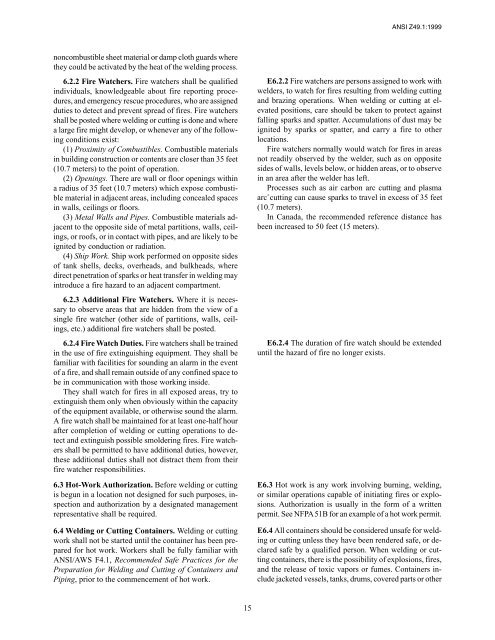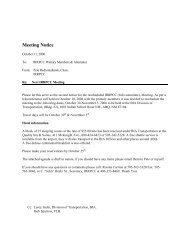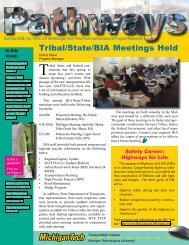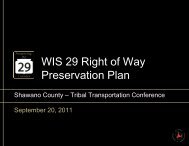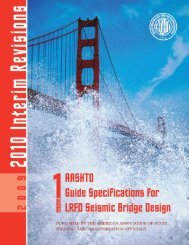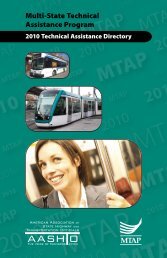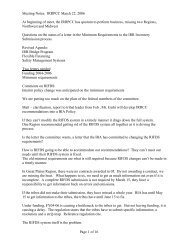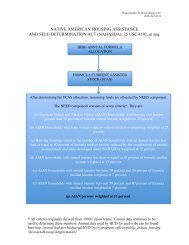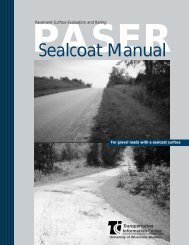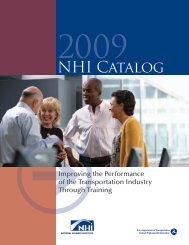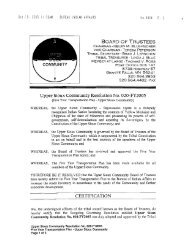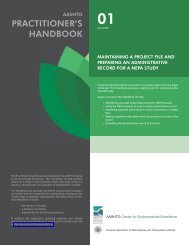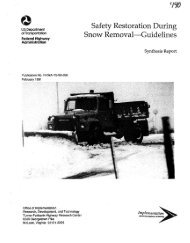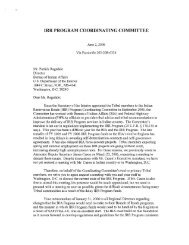Safety in Welding, Cutting, and Allied Processes
Safety in Welding, Cutting, and Allied Processes
Safety in Welding, Cutting, and Allied Processes
Create successful ePaper yourself
Turn your PDF publications into a flip-book with our unique Google optimized e-Paper software.
ANSI Z49.1:1999<br />
noncombustible sheet material or damp cloth guards where<br />
they could be activated by the heat of the weld<strong>in</strong>g process.<br />
6.2.2 Fire Watchers. Fire watchers shall be qualified<br />
<strong>in</strong>dividuals, knowledgeable about fire report<strong>in</strong>g procedures,<br />
<strong>and</strong> emergency rescue procedures, who are assigned<br />
duties to detect <strong>and</strong> prevent spread of fires. Fire watchers<br />
shall be posted where weld<strong>in</strong>g or cutt<strong>in</strong>g is done <strong>and</strong> where<br />
a large fire might develop, or whenever any of the follow<strong>in</strong>g<br />
conditions exist:<br />
(1) Proximity of Combustibles. Combustible materials<br />
<strong>in</strong> build<strong>in</strong>g construction or contents are closer than 35 feet<br />
(10.7 meters) to the po<strong>in</strong>t of operation.<br />
(2) Open<strong>in</strong>gs. There are wall or floor open<strong>in</strong>gs with<strong>in</strong><br />
a radius of 35 feet (10.7 meters) which expose combustible<br />
material <strong>in</strong> adjacent areas, <strong>in</strong>clud<strong>in</strong>g concealed spaces<br />
<strong>in</strong> walls, ceil<strong>in</strong>gs or floors.<br />
(3) Metal Walls <strong>and</strong> Pipes. Combustible materials adjacent<br />
to the opposite side of metal partitions, walls, ceil<strong>in</strong>gs,<br />
or roofs, or <strong>in</strong> contact with pipes, <strong>and</strong> are likely to be<br />
ignited by conduction or radiation.<br />
(4) Ship Work. Ship work performed on opposite sides<br />
of tank shells, decks, overheads, <strong>and</strong> bulkheads, where<br />
direct penetration of sparks or heat transfer <strong>in</strong> weld<strong>in</strong>g may<br />
<strong>in</strong>troduce a fire hazard to an adjacent compartment.<br />
6.2.3 Additional Fire Watchers. Where it is necessary<br />
to observe areas that are hidden from the view of a<br />
s<strong>in</strong>gle fire watcher (other side of partitions, walls, ceil<strong>in</strong>gs,<br />
etc.) additional fire watchers shall be posted.<br />
6.2.4 Fire Watch Duties. Fire watchers shall be tra<strong>in</strong>ed<br />
<strong>in</strong> the use of fire ext<strong>in</strong>guish<strong>in</strong>g equipment. They shall be<br />
familiar with facilities for sound<strong>in</strong>g an alarm <strong>in</strong> the event<br />
of a fire, <strong>and</strong> shall rema<strong>in</strong> outside of any conf<strong>in</strong>ed space to<br />
be <strong>in</strong> communication with those work<strong>in</strong>g <strong>in</strong>side.<br />
They shall watch for fires <strong>in</strong> all exposed areas, try to<br />
ext<strong>in</strong>guish them only when obviously with<strong>in</strong> the capacity<br />
of the equipment available, or otherwise sound the alarm.<br />
A fire watch shall be ma<strong>in</strong>ta<strong>in</strong>ed for at least one-half hour<br />
after completion of weld<strong>in</strong>g or cutt<strong>in</strong>g operations to detect<br />
<strong>and</strong> ext<strong>in</strong>guish possible smolder<strong>in</strong>g fires. Fire watchers<br />
shall be permitted to have additional duties, however,<br />
these additional duties shall not distract them from their<br />
fire watcher responsibilities.<br />
6.3 Hot-Work Authorization. Before weld<strong>in</strong>g or cutt<strong>in</strong>g<br />
is begun <strong>in</strong> a location not designed for such purposes, <strong>in</strong>spection<br />
<strong>and</strong> authorization by a designated management<br />
representative shall be required.<br />
6.4 Weld<strong>in</strong>g or Cutt<strong>in</strong>g Conta<strong>in</strong>ers. Weld<strong>in</strong>g or cutt<strong>in</strong>g<br />
work shall not be started until the conta<strong>in</strong>er has been prepared<br />
for hot work. Workers shall be fully familiar with<br />
ANSI/AWS F4.1, Recommended Safe Practices for the<br />
Preparation for Weld<strong>in</strong>g <strong>and</strong> Cutt<strong>in</strong>g of Conta<strong>in</strong>ers <strong>and</strong><br />
Pip<strong>in</strong>g, prior to the commencement of hot work.<br />
E6.2.2 Fire watchers are persons assigned to work with<br />
welders, to watch for fires result<strong>in</strong>g from weld<strong>in</strong>g cutt<strong>in</strong>g<br />
<strong>and</strong> braz<strong>in</strong>g operations. When weld<strong>in</strong>g or cutt<strong>in</strong>g at elevated<br />
positions, care should be taken to protect aga<strong>in</strong>st<br />
fall<strong>in</strong>g sparks <strong>and</strong> spatter. Accumulations of dust may be<br />
ignited by sparks or spatter, <strong>and</strong> carry a fire to other<br />
locations.<br />
Fire watchers normally would watch for fires <strong>in</strong> areas<br />
not readily observed by the welder, such as on opposite<br />
sides of walls, levels below, or hidden areas, or to observe<br />
<strong>in</strong> an area after the welder has left.<br />
<strong>Processes</strong> such as air carbon arc cutt<strong>in</strong>g <strong>and</strong> plasma<br />
arc˚cutt<strong>in</strong>g can cause sparks to travel <strong>in</strong> excess of 35 feet<br />
(10.7 meters).<br />
In Canada, the recommended reference distance has<br />
been <strong>in</strong>creased to 50 feet (15 meters).<br />
E6.2.4 The duration of fire watch should be extended<br />
until the hazard of fire no longer exists.<br />
E6.3 Hot work is any work <strong>in</strong>volv<strong>in</strong>g burn<strong>in</strong>g, weld<strong>in</strong>g,<br />
or similar operations capable of <strong>in</strong>itiat<strong>in</strong>g fires or explosions.<br />
Authorization is usually <strong>in</strong> the form of a written<br />
permit. See NFPA 51B for an example of a hot work permit.<br />
E6.4 All conta<strong>in</strong>ers should be considered unsafe for weld<strong>in</strong>g<br />
or cutt<strong>in</strong>g unless they have been rendered safe, or declared<br />
safe by a qualified person. When weld<strong>in</strong>g or cutt<strong>in</strong>g<br />
conta<strong>in</strong>ers, there is the possibility of explosions, fires,<br />
<strong>and</strong> the release of toxic vapors or fumes. Conta<strong>in</strong>ers <strong>in</strong>clude<br />
jacketed vessels, tanks, drums, covered parts or other<br />
15


